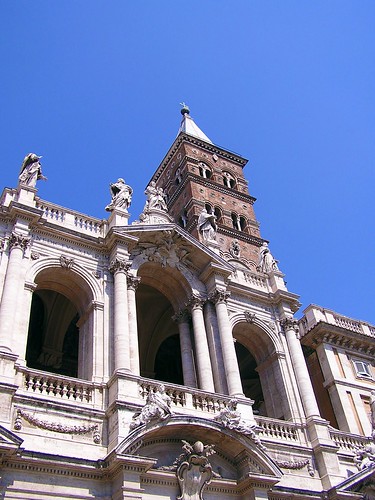
The façade is the magnificent work of Ferdinand Fuga (1741), and faces east, opening in a portico of five arcades on the lower story and three arches in the upper loggia, which covers the thirteenth-century mosaics of the previous façade.
Like precious gems set into the façade, the mosaics illustrate the origin of the Basilica. In the first scene, the Blessed Virgin appears to Pope Liberius and the Roman Patrician John in the dream that will inspire the location of the new basilica. An exceptional event would confirm the divine will - on August 5, 358, a snowfall covered the Esquiline Hill and in this snow, the Pope traced the perimeter of the future basilica.
Filippo Rusuti's majestic mosaics welcome visitors, arousing sentiments which draw man closer to the greatness of God. These precious remnants can only be visited through a special guided tour that gratifies the interest of those who contemplate these works of art.
Both in the loggia and in the façade, Fuga's Baroque tastes and vivid sense of space are amply demonstrated by his architecture. The lower five arches form the portico and support the triple arch of the loggia. This play of open space lightens the heaviness of the columns and their decorative capitals, entablatures, cornices, garlands and cherubs.
The statues accentuating the outline of the façade represent saintly Popes, as well as Saint Charles Borromeo and the Blessed Nicholas Albergati. Crowning the ensemble, as if hovering over from Heaven above, are the Madonna and Child. The façade seems almost like a tabernacle, allowing glimpses of the shimmering, polychrome mosaic concealed behind it.
The foundation stone for this façade was laid on March 4, 1741 by Pope Benedict XIV. Many eighteenth-century sculptors contributed to this remarkable project. The works both within and outside of the Basilica were completed just in time for the Jubilee Year 1750.
One hundred and fifty years separate the construction of the two palaces flanking the façade. Flaminio Ponzio built the structure on the right in 1605, while the second building was designed by Ferdinando Fuga in 1743 to give an overall uniformity to the site. Two graceful allegorical statues surmount the central entrance - Virginity by Giovanni Battista Maini, and Humility, carved by Pietro Bracci, who is also known for his sculptures at the Trevi Fountain.
From: www.vatican.va/various/basiliche/sm_maggiore/en/storia/fa...
Like precious gems set into the façade, the mosaics illustrate the origin of the Basilica. In the first scene, the Blessed Virgin appears to Pope Liberius and the Roman Patrician John in the dream that will inspire the location of the new basilica. An exceptional event would confirm the divine will - on August 5, 358, a snowfall covered the Esquiline Hill and in this snow, the Pope traced the perimeter of the future basilica.
Filippo Rusuti's majestic mosaics welcome visitors, arousing sentiments which draw man closer to the greatness of God. These precious remnants can only be visited through a special guided tour that gratifies the interest of those who contemplate these works of art.
Both in the loggia and in the façade, Fuga's Baroque tastes and vivid sense of space are amply demonstrated by his architecture. The lower five arches form the portico and support the triple arch of the loggia. This play of open space lightens the heaviness of the columns and their decorative capitals, entablatures, cornices, garlands and cherubs.
The statues accentuating the outline of the façade represent saintly Popes, as well as Saint Charles Borromeo and the Blessed Nicholas Albergati. Crowning the ensemble, as if hovering over from Heaven above, are the Madonna and Child. The façade seems almost like a tabernacle, allowing glimpses of the shimmering, polychrome mosaic concealed behind it.
The foundation stone for this façade was laid on March 4, 1741 by Pope Benedict XIV. Many eighteenth-century sculptors contributed to this remarkable project. The works both within and outside of the Basilica were completed just in time for the Jubilee Year 1750.
One hundred and fifty years separate the construction of the two palaces flanking the façade. Flaminio Ponzio built the structure on the right in 1605, while the second building was designed by Ferdinando Fuga in 1743 to give an overall uniformity to the site. Two graceful allegorical statues surmount the central entrance - Virginity by Giovanni Battista Maini, and Humility, carved by Pietro Bracci, who is also known for his sculptures at the Trevi Fountain.
From: www.vatican.va/various/basiliche/sm_maggiore/en/storia/fa...